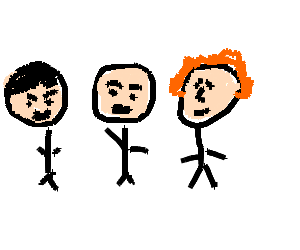The I Band
From Wakipedia, the free encyclopedia
Shrouded in mystery, lost in history.
The legend of a trio of gifted songwriters, but players of questionable talent, has been around the music world since the 60's.

Dubbed "The I Band" by Lionel Twanes, a modern day researcher in 2005, in reality the legend gives us no clue to what they actually did call themselves during their brief tenure in the music scene from 1959 to 1966.
What the legend does say, however, is that they ghostwrote a large portion of the hit songs released from 1962 to 1966.
Could the legend be true?
There was an abrupt shift of musical style in popular (or young people's) music in the early 1960's. The use of the reliable "C, Am, F, G" progression and simple themes began to fade as new, more complex music came on the scene. Songs by The Beatles, Dave Clark Five, Bob Dylan, and others began to show up on the charts. Soon, even established acts, began to release songs in this new musical style.
Were these actually written by this legendary trio? Did they actually change the face of popular music?
Or is it just ... a myth.
The Early Years
Early on the morning of December 8th, 1941, three babies were found on the doorstep of Our Lady of Perpetual Motion Orphanage in Staten Island, NY. Each one had a note pinned to their blankets with their name, heritage and religion written on it, as was the custom of the time.
They were probably left by the wives of overzealous young men who ran off to war (WWII) in the wake of Pearl Harbor. The wives most likely wanted to present their husbands with new babies after they returned from the war and were afraid that these babies would not be suitable for the conquering heroes' return. Not knowing how long the war would last, the wives were afraid that the babies would have acquired that "old child" smell by the time their husbands returned.
Anyway, the notes read: "Alevio (call him Lev) Friedland, German, Jewish", "Harlan Willoughby, English, Jehovah's Witness", and "Nestor Gleason, Puerto Rican/Irish, Roman Catholic".
Their early years are shrouded in mystery - and probably too boring to recount here. Nevertheless, by the time they were teens, they were back at the orphanage, eating gruel and sleeping on the floor covered by threadbare blankets - or so we can assume based on what we know of orphanages in the late 1950's. They were most likely beaten by the Nuns in order to reinforce the religious instruction. Hi-ho. Hi-ho.
The Teen Years
Information regarding their teen years has been gleaned from old police reports and the diary of one of the older nuns at the orphanage, Sister Mary Incontina.

The research was difficult because the police records were salvaged from a fire in 1972 and stored in a damp basement, and there were unidentified brown stains on the pages of the diary.
The police reports that were legible detail the usual teenage pranks of the day - public urination, gambling, lewd behavior in a school district, killing small animals, kidnapping and arson.
The diary, however paints a different picture.

At Calumet College - The Musical Awakening
On June 29, 1958, an incident occurred in Birmingham, Alabama.
On that evening’s news, there was a report that a bomb was discovered in the Bethel Baptist Church during an evening service. Fortunately, it was removed to a nearby open field and safely exploded killing only a few cows, destroying one cornfield and vaporizing old Beauregard McDonald, an itinerant laborer who was hunting snipe in the moonlight.
The pastor, Rev. Fred Shuttlesworth, was a Civil Rights activist and this bombing attempt was obviously the work of the local KKK or, possibly, an experiment gone wrong by the local high school chemistry club, who met in the church basement on alternate Tuesdays.
This event deeply affected Lev, Harlan and Nestor, who were incoming freshmen at Calumet College in St. Joseph, Indiana - a Roman Catholic school of little note.